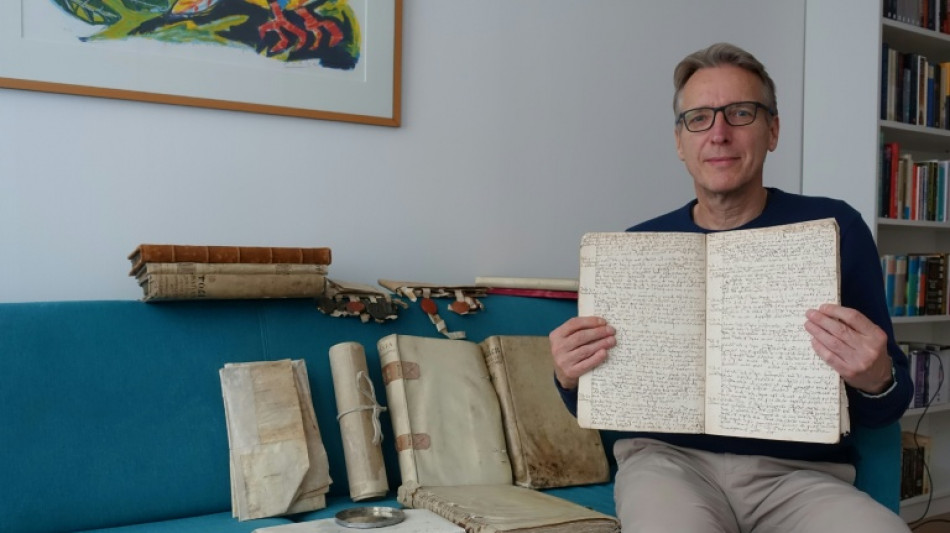
| SCS | 0.12% | 16.14 | $ | |
| RBGPF | -2.23% | 80.22 | $ | |
| RYCEF | 1.48% | 14.86 | $ | |
| RELX | -0.64% | 40.56 | $ | |
| RIO | 1.55% | 77.19 | $ | |
| GSK | -0.14% | 48.71 | $ | |
| NGG | 1.8% | 77.16 | $ | |
| BTI | -0.21% | 57.17 | $ | |
| BCE | -0.78% | 23.15 | $ | |
| CMSC | -0.34% | 23.26 | $ | |
| BP | 2.06% | 34.47 | $ | |
| CMSD | -0.43% | 23.28 | $ | |
| JRI | -0.6% | 13.43 | $ | |
| VOD | 0.86% | 12.81 | $ | |
| BCC | 0.59% | 76.29 | $ | |
| AZN | -1.66% | 89.86 | $ |
Dutch art sleuth recovers stolen trove of UNESCO-listed documents

A Dutch art sleuth has recovered a priceless trove of stolen documents from the 15th to the 19th century, including several UNESCO-listed archives from the world's first multinational corporation.
Arthur Brand, nicknamed the "Indiana Jones of the Art World" for his high-profile recovery of stolen masterpieces, said the latest discovery was among his most significant.
"In my career, I have been able to return fantastic stolen art, from Picassos to a Van Gogh... yet this find is one of the highlights of my career," Brand told AFP.
Many of the documents recount the early days of the Dutch East India Company (VOC), whose globetrotting trading and military operations contributed to the Dutch "Golden Age", when the Netherlands was a global superpower.
The 17th century VOC documents contain a "fascinating glimpse into the events of that time in places like Europe, India, Indonesia, South Africa and Latin America," said Brand.
One document from 1602 recounts the first meeting of the VOC, during which its famous logo -- considered the world's first corporate logo -- was designed.
VOC merchants criss-crossed the globe, catapulting the Netherlands to a world trading power but also exploiting and oppressing the colonies it conquered.
The company was also a leading diplomatic power and one document relates a visit in 1700 by top VOC officials to the court of the Mughal emperor in India.
"Since the Netherlands was one of the most powerful players in the world at that time in terms of military, trade, shipping, and colonies, these documents are part of world history," said Brand.
UNESCO agrees, designating the VOC archives as part of its "Memory of the World" documentary heritage collection.
"The VOC archives make up the most complete and extensive source on early modern world history anywhere," says UNESCO on its website.
The trove also featured early ships logs from one of the world's most famous admirals, Michiel de Ruyter, whose exploits are studied in naval academies even today.
De Ruyter gained fame for his daring 1667 raid to attack the English fleet in the River Medway, one of the greatest humiliations in world naval history.
The ship's logs, written in his own hand, relate the admiral's first experience of naval warfare, the 1641 Battle of St Vincent against the Spanish fleet.
- 'An extraordinary treasure' -
No less enthralling is the "who-dunnit" of how Brand came by the documents.
Brand received an email from someone who had stumbled across a box of seemingly ancient manuscripts while clearing out the attic of an incapacitated family member.
This family member occasionally lent money to a friend, who would leave something as collateral -- in this case the box of documents.
"I received some photos and couldn't believe my eyes. This was indeed an extraordinary treasure," Brand told AFP.
Brand investigated with Dutch police and concluded the documents had been stolen in 2015 from the vast National Archives in The Hague.
The main suspect -- an employee at the archives who had indeed left the box as collateral but never picked it up -- has since died.
Brand compared the theft to a daring heist by a curator at the British Museum, who spirited away some 1,800 objects, selling some of them on eBay.
The art detective said he spent many an evening sifting through the documents, transported back in time.
"Wars at sea, negotiations at imperial courts, distant journeys to barely explored regions, and knights," he told AFP.
"I felt like I had stepped into Robert Louis Stevenson's 'Treasure Island."
F.Ciambrone--INP

 London
London

 Manchester
Manchester
 Glasgow
Glasgow
 Dublin
Dublin
 Belfast
Belfast
 Washington
Washington
 Denver
Denver
 Atlanta
Atlanta
 Dallas
Dallas
 Houston Texas
Houston Texas
 New Orleans
New Orleans
 El Paso
El Paso
 Phoenix
Phoenix
 Los Angeles
Los Angeles



